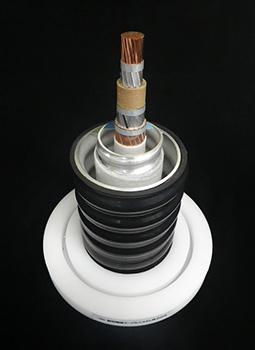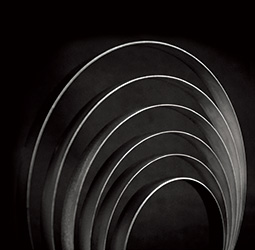Home > Highlighting JAPAN > Highlighting Japan January 2018 > Sustainable Technologies from Japan
Highlighting JAPAN


Energy Saving with Superconducting Cable
An innovative technology for the production of superconducting cable is expected to contribute significantly to energy savings in power transmission.
When specific materials are cooled to very low temperatures, electrical resistance suddenly falls to zero. This phenomenon is called superconductivity. Discovered in the early twentieth century, it can only be observed in extremely low temperature ranges close to absolute zero (-273°C), and for a long time was not applied to manufactured goods. In recent years, materials that reach superconductivity in relatively high temperature ranges have been discovered one after another, and today various studies for their commercialization have gained momentum around the world.
One such product is a triaxial superconducting cable. Showa Cable Systems Co., Ltd. (SWCC), headquartered in Kawasaki City, Kanagawa Prefecture, is working on the practical application of energy-saving products, subsidized by the New Energy and Industrial Technology Development Organization (NEDO). Yuji Aoki, who heads the Superconducting Applied Products Development Section at the SWCC R&D Center, says this about the system of running electricity with zero electrical resistance:
“A triaxial superconducting cable uses a superconductor called yttrium system, whose distinguishing feature is that it reaches superconductivity at the boiling point of liquid nitrogen (-196°C). With existing superconductors (e.g., NbTi or Nb3Sn) employed in applications such as MRI (magnetic resonance imaging) equipment for medical use, the temperature must be cooled using liquid helium (boiling point -269°C). Compared with this, electrical resistance in yttrium system reaches zero at a much higher temperature. It is thought that helium resources will be depleted in the future, but nitrogen is inexhaustibly present in the atmosphere, so energy shortages are not concerned.”
In the case of the triaxial superconducting cable, a raw material solution including an organic solvent of yttrium, barium and copper is thinly coated onto a metallic substrate with an oxide buffer layer, which is then heat treated, forming a superconductive crystal thin-film layer. Previously, this process of creating a thin film necessitated a vacuum process, but the development of a new manufacturing method (called the MOD method) has enabled the production of superconducting cable at low cost and with extremely small loss of energy from the raw material without a vacuum process.
This has all been made with the technology and know-how cultivated by SWCC during more than eight decades since its establishment as an electrical cable manufacturer.
“Many people probably think that even if electrical resistance is zero, once it becomes necessary to bring in cooling devices, it is not cost-effective. However, the energy loss associated with power transmission is very large, which is why the local production and consumption of electricity is said to be the ideal scenario. Currently, in order to minimize this power transmission loss, electricity generated at power plants is being sent to the site of consumption after being subjected to ultra-high voltage using a transformer. However, considerable energy loss is occurring even just with the generation of heat in the bus line section connecting the generator and transformer.
If we eliminate this loss by using our triaxial superconducting cable here, this alone will produce sufficient profit,” says Aoki.
According to tentative estimations, energy loss as a result of electrical resistance of the bus lines in all the thermal power plants in Japan is 240,000 kiloliters per year when converted to crude oil. Further, existing bus lines are composed of three single phase cables with thick 700mm diameters, but when these are replaced by superconducting cables, only a single cable of 154 mm in diameter is required, which has significant space-saving benefits in addition to cost-reduction benefits through energy saving.
“Currently, the triaxial superconducting cable is still at the demonstration testing stage, but the technology of superconducting cable in yttrium system that has been developed has possible application in a variety of fields, including superconducting magnets and superconducting motors.
In addition, at plants that have already used liquid nitrogen—iron mills and petrochemical complexes, for example—the use of that liquid nitrogen to cool the superconducting cable can greatly reduce the initial expense of installing superconducting cable as well as significantly decrease running costs.
If superconducting cable is further developed, in the future it may be possible to transmit electricity generated by solar power systems installed in the Sahara Desert to Europe,” says Aoki with a brightening in his eyes.
Once demonstration testing is completed, further potential applications for superconductivity will be surely extended.
© 2009 Cabinet Office, Government of Japan








